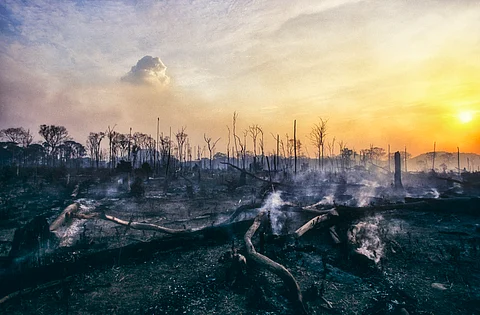

Amazon forests in Brazil burned by fires remain up to 2.6°C hotter than intact forests, with heat persisting for at least 30 years.
Burned forests show fundamental changes in energy balance and canopy structure, increasing light penetration and heat stress.
High leaf temperatures slow or prevent natural regeneration, threatening the forest’s ability to sequester carbon.
Researchers warn that climate strategies must account for reduced carbon capture in fire-affected tropical forests.
Amazon forests in Brazil that have been scorched by fire can continue to sizzle for decades compared with intact or even selectively logged areas, hampering their recovery and weakening their ability to cope with climate stress and store carbon, a new study has found.
Researchers from Columbia University’s Climate School, whose findings were published in the journal Environmental Research Letters, reported that fire-affected areas remain on average 2.6 degrees Celsius (°C) warmer than intact forest — and that this heat can linger for at least 30 years.
“Degraded tropical forests in particular may be approaching critical temperature thresholds even more rapidly than intact forests, with implications for tree survival and ecosystem recovery,” the paper stated.
The team found that burned forests exhibited a fundamental shift in their energy balance, with structural damage across all canopy layers increasing light penetration and heat loading. In the southern and eastern Amazon, where they conducted the research, forests also face regular seasonal water stress, further compounding the thermal burden.
By modelling leaf temperatures across the forest canopy on some of the hottest recorded summer days, the researchers found that 87 per cent of leaves in the warmest burned patches exceeded critical temperature thresholds, where leaf respiration outstripped photosynthesis. In comparison, only 72-74 per cent of leaves in intact or logged forests hit that threshold under the same conditions.
After accounting for environmental factors, the study estimated that burned forests were, on average, 2.6°C warmer than intact forests across canopy heights of 5-40 metres, with a 95 per cent credible range of 1.39°C-3.96°C. Even after 30 years of recovery, the temperature decrease was only about 1.2°C.
Leaf temperature distributions in burned forests showed both higher peaks and broader spread, with roughly three-quarters of light-exposed leaves in the hottest areas exceeding critical heat thresholds.
“Burned forests exhibited substantially altered thermal regimes even after 15 years of recovery, with consistently elevated temperatures across all canopy heights,” the researchers observed. Unlike intact or logged forests, burned areas showed a slight temperature increase with height — 0.51°C from 5 to 40 metres — suggesting that damage to the upper canopy reduced evaporative cooling.
These changes, the researchers warned, affect the forest’s natural regeneration. Elevated and variable temperatures can hinder seed germination, seedling establishment and sapling growth, meaning heavily degraded areas may require active restoration rather than relying on natural recovery.
“We’re finding that burning has major ecological impacts over large timescales and that regeneration is much more at risk — it’s slower or not happening at all,” said lead author Savannah Cooley, a research scientist at National Aeronautics and Space Administration Ames Research Center and a recent PhD graduate of Columbia’s Ecology, Evolution and Environmental Biology (E3B) programme in a press statement.
Unlike fire-adapted ecosystems such as savannahs or pine forests, the Amazon evolved in a humid climate where natural fires were rare. As a result, many tropical tree species lack traits to tolerate or recover from fire damage, the scientist pointed out.
The study concluded that climate mitigation strategies must account for the reduced carbon sequestration capacity of tropical forests, particularly those struggling to recover after fires.